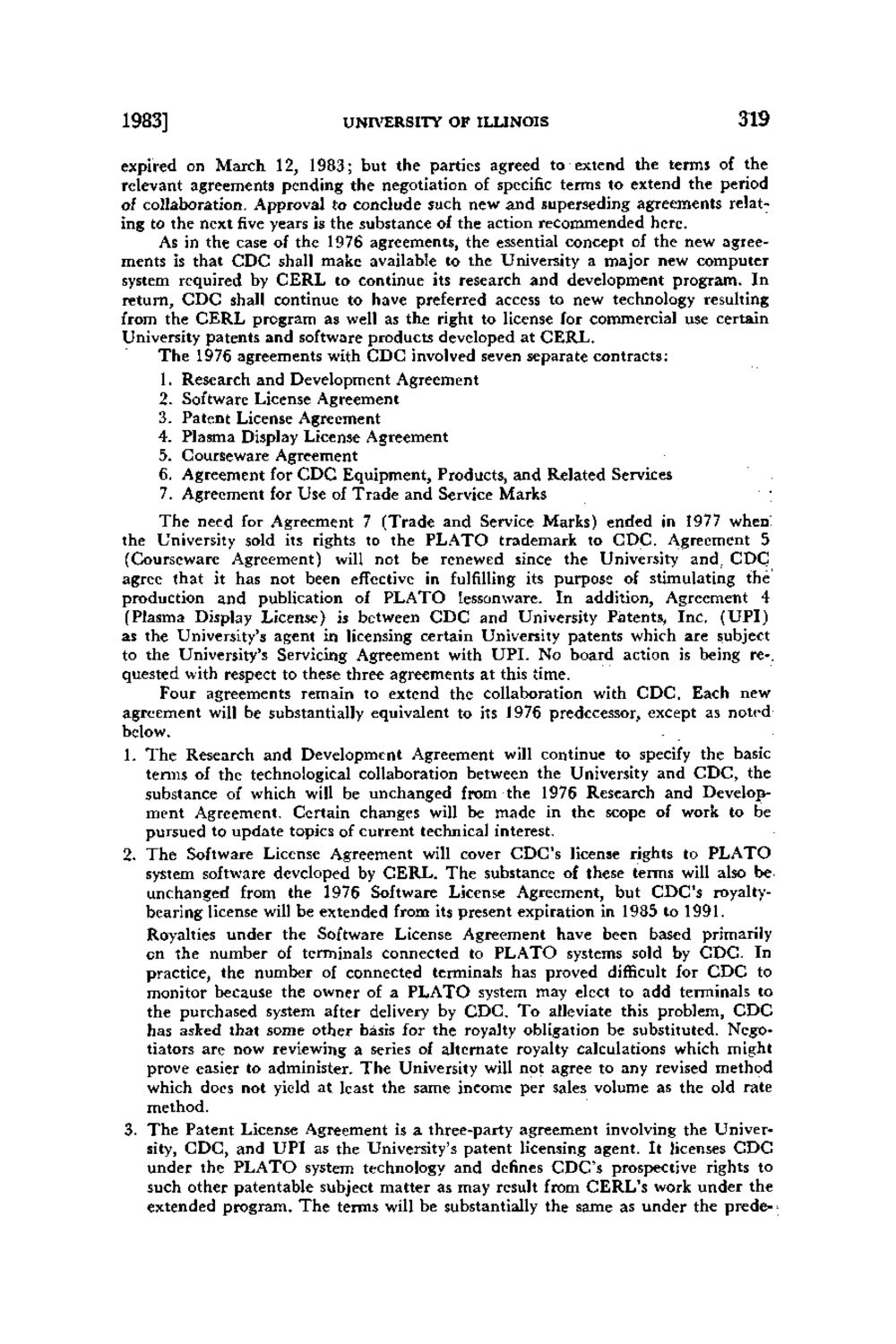| |
| |
Caption: Board of Trustees Minutes - 1984
This is a reduced-resolution page image for fast online browsing.

EXTRACTED TEXT FROM PAGE:
1983] UNIVERSITY OF ILLINOIS 319 expired on March 12, 1983; but the parties agreed to extend the terms of the relevant agreements pending the negotiation of specific terms to extend the period of collaboration. Approval to conclude such new and superseding agreements relating to the next five years is the substance of the action recommended here. As in the case of the 1976 agreements, the essential concept of the new agreements is that CDC shall make available to the University a major new computer system required by C E R L to continue its research and development program. In return, CDC shall continue to have preferred access to new technology resulting from the CERL program as well as the right to license for commercial use certain University patents and software products developed at CERL. The 1976 agreements with CDC involved seven separate contracts: 1. Research and Development Agreement 2. Software License Agreement 3. Patent License Agreement 4. Plasma Display License Agreement 5. Courseware Agreement 6. Agreement for CDC Equipment, Products, and Related Services 7. Agreement for Use of Trade and Service Marks The need for Agreement 7 (Trade and Service Marks) ended in 1977 when! the University sold its rights to the P L A T O trademark to CDC. Agreement 5 (Courseware Agreement) will not be renewed since the University and CDC agree that it has not been effective in fulfilling its purpose of stimulating the production and publication of PLATO lessonware. In addition, Agreement 4 (Plasma Display License) is between CDC and University Patents, Inc. ( U P I ) as the University's agent in licensing certain University patents which are subject to the University's Servicing Agreement with U P I . No board action is being re-, quested with respect to these three agreements at this time. Four agreements remain to extend the collaboration with CDC. Each new agreement will be substantially equivalent to its 1976 predecessor, except as noted below. 1. The Research and Development Agreement will continue to specify the basic terms of the technological collaboration between the University and CDC, the substance of which will be unchanged from the 1976 Research and Development Agreement. Certain changes will be made in the scope of work to be pursued to update topics of current technical interest. 2. The Software License Agreement will cover CDC's license rights to P L A T O system software developed by CERL. T h e substance of these terms will also be unchanged from the 1976 Software License Agreement, but CDC's royaltybearing license will be extended from its present expiration in 1985 to 1991. Royalties under the Software License Agreement have been based primarily en the number of terminals connected to P L A T O systems sold by CDC. In practice, the number of connected terminals has proved difficult for CDC to monitor because the owner of a P L A T O system may elect to add terminals to the purchased system after delivery by CDC. To alleviate this problem, CDC has asked that some other basis for the royalty obligation be substituted. Negotiators are now reviewing a series of alternate royalty calculations which might prove easier to administer. The University will not agree to any revised method which docs not yield at least the same income per sales volume as the old rate method. 3. The Patent License Agreement is a three-party agreement involving the University, CDC, and U P I as the University's patent licensing agent. It licenses CDC under the P L A T O system technology and defines CDC's prospective rights to such other patentable subject matter as may result from CERL's work under the extended program. T h e terms will be substantially the same as under the prede-
| |